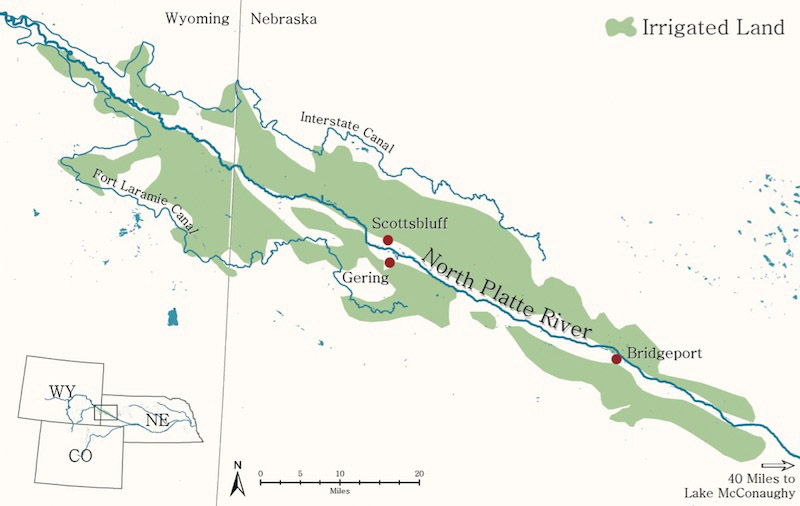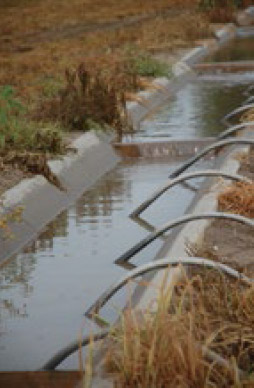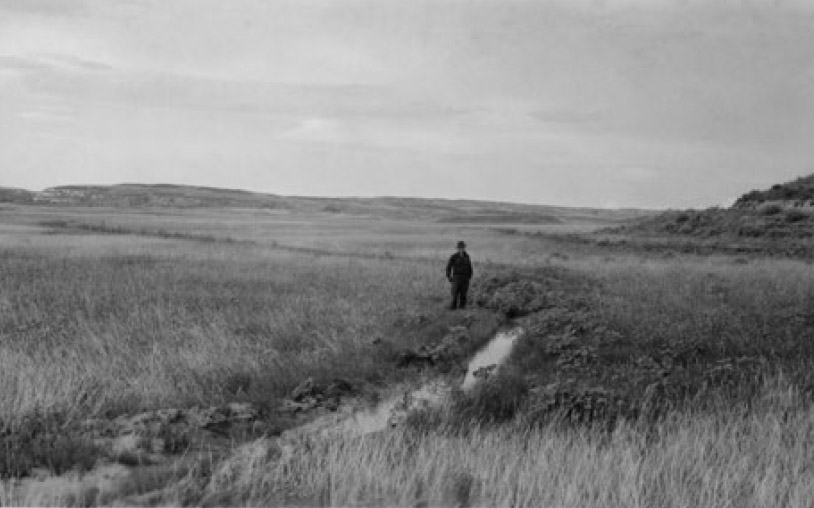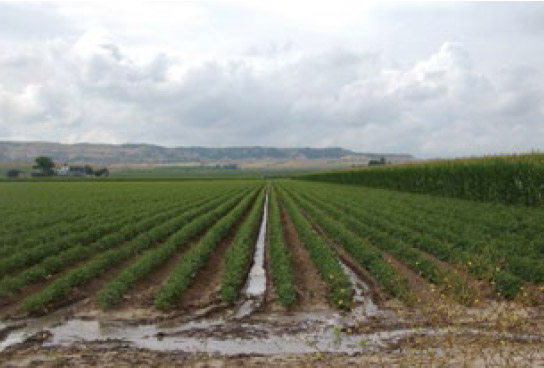Upstream Efficiencies Mean Less Water For Downstream Users in Nebraska’s Panhandle
On a warm summer morning in western Nebraska, 77-year-old farmer Bob Busch stood next to a sugar beet field in a worn denim shirt, black suspenders and a mesh hat. At his feet, water coursed past in a concrete-lined irrigation ditch. A series of slender, curved pieces of aluminum pipe siphoned the water out of the ditch and onto the field.
This is one style of flood irrigation, a method that has been in use since the late 1800s when enterprising settlers began to divert water from the North Platte River to irrigate croplands and build an agricultural economy in western Nebraska. Busch lives in a jagged patch of verdant farmland on the western edge of the arid Nebraska panhandle, about 10 miles west of where the North Platte River flows through Scottsbluff. His farm, like many in the green patchwork around him, is completely dependent on irrigation from the North Platte River.

Peter Stegen, Platte Basin Timelapse
When Busch first started to irrigate, he said, it was pretty crude. Back then, there weren’t even tubes to siphon the water, just cuts in the side of a dirt ditch. Pointing back to the ditch at his feet, Busch described how thirty-some years ago this canal “was all sod. It was a nightmare to irrigate out of.” Concrete was available, so Busch started cementing his ditches.
Technically, Busch retired seven years ago. But he still works every day, helping his son take care of roughly 1,000 acres of sugar beets, dry beans, corn, and alfalfa, and irrigating from May through September. Through many decades of farming, he and farmers like him have struggled to make the most of a limited supply of water. Busch has seen, and contributed to, dramatic changes in irrigation technology and efficiency. Sealing canals with concrete is just one of those changes.
“I’ve seen a tremendous impact of going from sod ditches, dirt ditches to concrete ditches to gated pipe to plastic ditch. And then the pivots started going up,” Busch said.
Water seeping through porous canals and ditches has always been an issue for irrigators, so districts and farmers alike have lined or sealed the waterways to reduce loss. “We can’t afford to lose a whole lot of water out of the canal,” Busch said, but “sealing a canal is a catch-22 because that water that comes out of them canals does replenish our groundwater system.”
![]()
On a dusty road on the outskirts of Gering, Nebraska, not far from the local sugar beet processing plant, sits the main office of the Gering-Ft. Laramie Irrigation District. Inside, manager Rick Preston’s office is a small museum to the history of irrigation. Big, detailed maps cover the tables and a bookshelf full of old surveying and irrigation equipment lines the back wall.

Steven Speicher, Platte Basin Timelapse
This is one of several irrigation districts in the Nebraska panhandle that deliver water diverted from the North Platte River to farmers. When he first started with the district 20 years ago, Preston said nearly all of the district’s 55,000 acres used gravity flow, or flood, irrigation, including those owned by Busch. Now he estimates about half the district has converted to sprinkler systems including center pivots, which deliver precise amounts of water to the crops instead of flooding them. Through the years his district has put about half of its laterals—smaller ditches that divert water from the main canal to fields—into pipe.
Numerous factors have motivated irrigators to become more efficient in getting water from the river to their fields. In the late 1950s and ’60s, the government lent money to finance lining ditches and putting laterals into pipes to reduce seepage. More recently, finding and keeping good workers on the fields has become difficult, and center pivots require far less manual labor than flood irrigation.
“In agriculture it’s a seven day a week job from when it’s time to plant, up until it’s time to harvest. A lot of individuals today do not want to have to give up their summers and weekends to do this type of work,” Preston said, “so the work force has dwindled tremendously.” Siphon tubes have to be moved by hand every day, whereas center pivots can be operated by the push of a button.
And there are other reasons to convert to sprinklers. Pivots reduce the need for tilling and help with erosion. Changing climate and weather patterns also play a role, because so much depends on how much moisture arrives in the mountain headwaters of the North Platte River and in the panhandle region itself, translating to soil, river and groundwater recharge. Drought, particularly during the last decade, often leads to irrigation water shortages, and makes the water that seeps away from unlined canals and ditches all the more valuable and worth trying to hold onto.
“From the late ’60s to present day we more than doubled the ability to deliver water to the farm,” Preston said. Now, much of the water that used to seep into the ground makes it to the fields, delivered through piped laterals or concrete ditches like the one on Busch’s farm.

irrigation ditch.
Ariana Brocious, Platte Basin Timelapse
Kevin Adams, general manager of the nearby Farmers Irrigation District, is familiar with the system of water loss through unlined canals. His district’s main earthen canal stretches 75 miles from the Tri-State Diversion Dam, just east of the Wyoming-Nebraska state line. Walking alongside it on a sunny afternoon just before the end of irrigation season, Adams pointed to the water gurgling under a bridge, and said the district loses about one-third of that water into the aquifer through seepage, about 1,000 acre feet per day.
But the water that seeps out of canals and ditches doesn’t disappear for good.
“We lose it and it shows up in the creeks, in the river and going downstream,” Adams said. “We supply the aquifers in western Nebraska.”
![]()
Nick Lapaseotes is a tall man, and his Greek heritage shows in the olive tone of his skin and bright eyes above the salt-and-pepper stubble across his chin. Over the years, he has adopted all the highest-tech solutions for getting water to his crops on his 10,000-acre farm. But he’s still affected by diminishing water supplies, in his case, groundwater.
As he strode out to one of his sugar beet fields outside of Bridgeport, Nebraska, thirty miles down the North Platte River from Gering, he explained that until three years ago, he irrigated this field by gravity flow, using water pumped up from the aquifer. Now a long stretch of silver pipes spanned the field, sprinkling water down in a fine mist to the broad, green leaves of the beets below. That’s been the case on many of his fields as Lapaseotes has converted more and more of his acreage to pivots.
Lapaseotes knows a lot about center pivots. The technology was refined in Nebraska, which remains their leading producer today. His father began investing in pivots and putting them on land he owned starting in the late 1960s, expanding year after year, Lapaseotes said. When he and his brother returned to the family land after school, they followed in their father’s entrepreneurial footsteps, updating irrigation operations with the latest technology.
He walked over to the pivot control box on the side of the field and showed off the panel inside. “We got a lot of these computerized panels now so we can control ’em from the office,” Lapaseotes said. He demonstrated an hour later back in his office, turning the same pivot on and off with the click of a mouse.
On one field, he cut his water use by 20 percent using subsurface drip irrigation, which feeds water to plant roots through perforated plastic tubes laid under the dirt. That method has become more popular in recent years as farmers seek to make even more of the water they get, especially in dry years when water supplies are curtailed. Soil moisture probes on about a quarter of his fields measure precisely how much water crops need, and Lapaseotes can review the data from an iPad in the cab of his truck or miles away back in his office.

American Heritage Center
It might sound like all this new water delivery efficiency—concrete-lined ditches, piped laterals, sprinklers, drip irrigation—is helping irrigators make diminishing water supplies go further, but the truth is more complicated. As farmers use water more precisely, there’s less flooding on fields, reducing what water users call “return flows.” Return flows describe water that flows off a field back into an irrigation ditch, or goes back into creeks, streams, and the river where it is ready for use by other irrigators downstream. Some of it even seeps through leaky ditches, canals and fields back to the groundwater table, where it may contribute to river levels downstream weeks, months, or even years later.
“We operate this system on return flows,” Preston said. His district, designed around the older system of flood irrigation, depends on that return water, particularly during years of water shortage.
In fact, farmers and water managers in the Nebraska panhandle are fond of saying that their water is used seven times before it meets the Missouri River on the state’s eastern border. Adams cited this maxim too, but said things started to change in the early 1990s. He’s worked for the Farmers Irrigation District for the past 35 years and has seen an even greater conversion from furrow irrigation to pivot than Preston has—nearly 70 percent of the district’s 65,000 acres are now under pivots.
“When we were gravity flow irrigating our system we would get percolation return flows,” Preston said, but the use of pivots has reduced that by about 50 percent.
Like many irrigators in the panhandle, Lapaseotes runs most of his pivots on groundwater. In the last half-century, farmers have increasingly turned to groundwater to supplement surface water supplies. Adams said that adds another layer of complexity to the return flows equation.
Groundwater levels in Nebraska declined an unprecedented 2.5 feet on average from 2012 to 2013. A statewide report attributed the drop to increased groundwater pumping and decreased precipitation recharge, both exacerbated by drought in 2012. Excessive groundwater pumping can draw the underground water table below the levels of streams and rivers, further hampering the system of return flows that many users depend upon.
“Twenty-five years ago, you could pump unfettered if you wanted to,” said John Berge, general manager of the North Platte Natural Resources District. “We don’t allow that anymore.”
![]()
In 1972, Nebraska put groundwater management in the hands of locally elected boards organized by river basins. The 23 Natural Resources Districts (NRDs), as they’re called, work with surface water districts, municipalities, local and state government to monitor and regulate groundwater use and quality. The North Platte Natural Resources District covers about five and a half counties from the Wyoming state line down to the western end of Lake McConaughy, a huge reservoir built for irrigation and power generation in central Nebraska.
“We’re one of a few NRDs in the state designated as over-appropriated,” said Berge. As a result, his district monitors pumping on all existing groundwater wells to understand what that usage has done to static water levels. In 2002, the North Platte NRD put a moratorium on any new irrigation wells in the district. The district is also working on a groundwater recharge project—leasing surface water off a parcel of land and putting it into a pit to seep back into the ground.
“We’re regulating the groundwater pretty heavily,” Berge said. A 2004 law required NRDs in “over or fully appropriated” river basins to cut back on irrigated acreage and groundwater use. In response, the North Platte NRD limited acreage expansion and put limits on groundwater use from existing wells in the over-allocated part of the district. Most of Lapaseotes’s groundwater wells are subject to limits and have been for the last decade.

Peter Stegen, Platte Basin Timelapse
Diminishing return flows—be it from more efficient measures on farms and irrigation districts, less snow and rain in the mountains and plains, cropping practices, drought, increased groundwater pumping, or other factors—affect water supplies beyond the panhandle itself. Return flows from the panhandle that eventually make it back to the North Platte River flow downstream to Lake McConaughy. Central Nebraska Public Power and Irrigation District, which runs the reservoir and supplies irrigation water to 223,000 acres in the center of the state, sees decreased return flows affecting its water supply. Lake inflows dropped by more than 30 percent between 1943 and 2013, which Central attributes to the 100-fold increase in groundwater wells in the panhandle during that time period.
Berge is aware of Central’s assertion. “The overarching piece is simply that we have far too much consumptive use in this district,” Berge said, referring to water that gets used by plants and never makes it back into the system.
There are three ways to reduce consumptive use, Berge said: provide less irrigation water to farmers, reduce the number of farmed acres, or convert to less thirsty crops like wheat. While none of these is popular, it’s a matter of figuring out what strategy works best, Berge said. For example, some current irrigated lands could instead be used for wildlife habitat, hunting, or ranching. His district is looking at all these options to try to avoid “draconian measures” like further restrictions on irrigation water use, Berge said.
He’s in a tricky spot, because even as farmers in his district and those upstream find new ways to maximize crop production from limited water supplies, they are further limiting water supplies.
“We hear about efficiency all the time,” Berge said. And when it comes to water resources and quantity, “you want to make sure that that water is used as efficiently and effectively as possible.” But “the inefficiencies in the surface water system can be helpful to the groundwater system,” Berge said.
With farmers becoming more efficient, “the ultimate change is that we no longer have the recharge getting into our aquifer, which slows the timing back to the river, which diminishes the stream flow in the river, which is a significant part of our problem out here,” Berge said.
![]()
By mid-September, early beet harvest was already underway in Scottsbluff. Sugar beets piled in giant mounds under the tall white silos of Western Sugar’s plant, looking like huge piles of dirt from a distance. The air around the sugar processing plant smelled sour as harvesters and loaders worked late into the night. Irrigation season had just ended, and farmers picked up pipe and turned off pivots.
There’s no easy answer to the paradox of competing and complementary surface and groundwater supplies.
“You know, we’re not different than any part of the state. The population’s growing. Municipalities. Factories. Water’s being used,” said Adams of the Farmers Irrigation District. “And over-appropriated, of course.”
“With the increased demand for the produce, the increased demand for the livestock feeds, the increased amount for water, it’s going to continue to get worse and more demanding as time goes on,” Preston said.
Perhaps it’s natural to feel disheartened after a career of such challenges. But John Berge, who’s relatively new to the North Platte NRD, takes a different angle.
“You look at this … and you can get really depressed and you can say, ‘Oh my God, we’re never gonna be able to fix this.’ [But] ultimately, it’s a pretty cool opportunity,” Berge said.
We’re at a new point in our agricultural history, he said. For decades, the overall policy was to plant as much as you possibly can, Berge said. “Now we’re kind of pulling back and saying, let’s do this the smart way.”
By Ariana Brocious, Platte Basin Timelapse
Ariana Brocious is lead reporter for Platte Basin Timelapse, a multimedia documentary project that aims to increase understanding about water resources and build community throughout a watershed. Videos, interactive graphics, and more stories at plattebasintimelapse.com.


